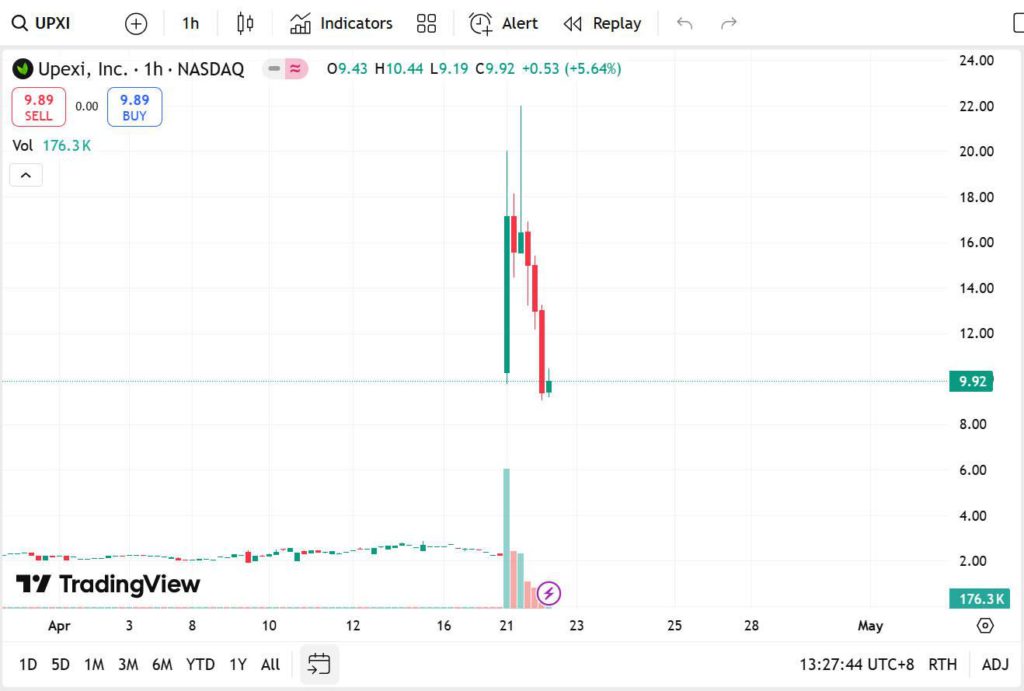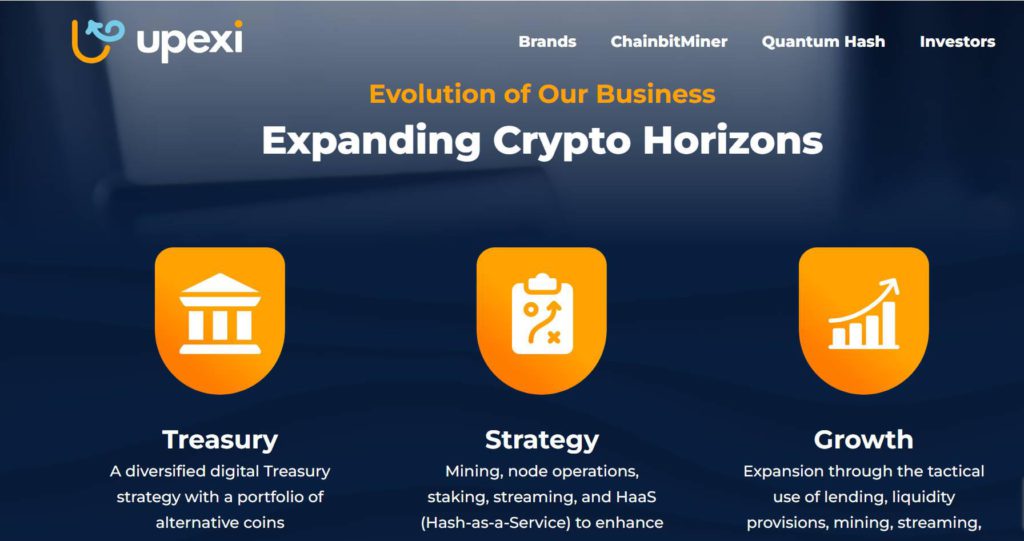Following the trend of Bitcoin investment and financial strategy accumulation, the Solana strategy has many imitators, including the Canadian listed company Sol Strategies Inc., the NASDAQ-listed company Janover, and the consumer goods listed company Upexi, which has become the latest traditional company to adopt a similar strategy.
On April 21, the well-known crypto trading and investment company GSR announced that it had made a private investment in public equity (PIPE) of up to $100 million in the NASDAQ-listed consumer goods company Upexi, Inc. (ticker: UPXI), betting on its upcoming comprehensive Solana financial strategy. Affected by the news, Upexi's stock price surged by over six times during the day.
As early as February this year, Upexi had announced a roadmap around cryptocurrencies. This consumer goods development, manufacturing, and distribution company showed a significant decline in revenue in its latest financial report, with continued net losses. Embracing cryptocurrencies has become a transformation strategy.
GSR Bets on Upexi's Solana Financial Strategy, Leads $100 Million Private Equity Investment
GSR provided direct financial support for Upexi's new on-chain strategy. Upexi announced that it has signed a securities purchase agreement with some investors to issue 43,859,649 common shares (or prepaid warrants as an alternative) at $2.28 per share, with a total fundraising amount of approximately $100 million (before deducting placement agent fees and other issuance expenses).
Upexi plans to use about $5.3 million for working capital and debt repayment, with the remaining funds to be used for building the company's Solana-based fiscal system and accumulating Solana assets.
In addition to GSR leading the investment, many crypto institutions and individuals participated in this round of financing, including Big Brain, Anagram, Delphi Ventures, White Star Capital, Maelstrom (Arthur Hayes family office), Hivemind, Borderless, Morgan Creek, Elune Capital, Delta Blockchain Fund, and more. Several well-known angel investors also participated, including Austin Federa, Frank Chaparro, Joey Krug, Bartosz Lipinski, Larry Wu, Jordan Prince, and Upexi CEO Allan Marshall.
Solana Foundation President Lily Liu also stated that this transaction marks another step in connecting traditional financial institutions with decentralized infrastructure.
The market performance after the announcement showed that the NASDAQ-listed Upexi's stock price rose by 639.20% to $16.78. By the close of the US stock market on April 21, Upexi's stock price had fallen back to $9.89.

While attracting widespread attention in the crypto market, some crypto industry professionals also offered their positive views. Arif Kazi, Business Development Lead at Sonic SVM, said on the X platform: "There's been a shift in public market perception of on-chain yields. Upexi is not hedging risks - they view SOL staking as infrastructure. Native staking is becoming an institutional-grade financial instrument."
He stated that this might be the largest Solana native fiscal allocation for a US listed company. Priced above market value, without tokens, lockup, or convertible debt terms. Solana's architecture makes this possible: parallel execution through Sealevel technology, sub-second finality time, and a stable validator network layer. This is infrastructure built for institutions. When fiscal strategies combine with DeFi primitives, it's not just a fit, but an acceleration. Solana now provides a playbook for capital allocators.
From Soft Candy to Crypto: Upexi's On-Chain Transformation

Upexi, headquartered in Tampa, Florida, was previously focused on consumer goods R&D, manufacturing, and distribution, with brands including medicinal mushroom product Cure Mushrooms, pet care brand LuckyTail, and the Prax series of energy gummies. Although this traditional consumer goods model once allowed it to establish a foothold in the market, it has never gained significant attention in the capital markets, with a market value of only $3 million as of April 18 (local time last Friday).
Upexi, Inc.'s latest financial report reveals significant financial challenges. During the 6 months ending December 31, 2024, the company's revenue declined, and net losses continued. The revenue for the reporting period was $8.36 million, a significant drop from $15.74 million in the same period last year. The company's net loss was $2.93 million, slightly better than the $3.79 million loss in the previous year.
Facing such financial pressure, crypto is viewed as a new opportunity by Upexi. In fact, Upexi's crypto strategy had been gradually unfolding months ago. On March 3, Upexi announced that its subsidiary Quantum Hash has signed a letter of intent (LOI) to acquire a 2 MW crypto mining facility. The facility currently has less than half utilization. Quantum Hash plans to upgrade existing equipment and introduce the latest, fastest mining machines after the transaction to maximize computing power and monthly Bitcoin production.
On February 6, Upexi announced that it is actively seeking further investment opportunities by directly investing in Altcoins, mining businesses, and mergers and acquisitions in the fintech field. The company updated shareholders on its current business operations and disclosed its long-term crypto and mining strategic plan.
Upexi's CEO Allan Marshall, 55, joined the company as CEO in May 2019 after retirement, having been a serial entrepreneur focusing on the tech industry in recent years. His career began in transportation and logistics. He stated, "The company is in a series of rapidly developing opportunities and will continue to promote the implementation and advancement of various strategies in the coming weeks and months."
According to the official website, after transformation, Upexi has the following development strategies: First, a financial strategy: a diversified digital financial strategy covering multiple Altcoin asset portfolios; second, strategic direction: enhancing financial returns through mining, node operations, Staking, streaming services, and HaaS (Hash as a Service). In terms of growth path, the company will expand its business through strategic use of lending, liquidity provision, mining, streaming services, and capital markets.
Currently, Upexi has announced its strategic roadmap for 2025, including:
Bitcoin and Altcoin Mining: Owning at least 1-3 MW of low-electricity-price mining operations within 90 days; completing due diligence on current 2-5 MW ongoing mining projects; targeting development of 10-20 MW mining facilities; expanding mining business to other Altcoins like Ethereum and AI-driven blockchain assets.
Crypto Asset Portfolio Building: Constructing a diversified digital asset portfolio, including Bitcoin, Ethereum, Solana, Render, Chainlink; strategically buying during market fluctuations; holding assets with blockchain infrastructure growth potential and AI integration value.
Blockchain-based Financial Focus Direction: Exploring opportunities in Staking, DeFi Lending, blockchain projects with revenue generation models.
Long-term focus areas include Web3, DeFi, AI-driven blockchain growth.
SOL Strategy Aims for Organic Growth, Market Volatility May Bring "Unrealized Loss Dilemma"
In this investment by GSR in Upexi, no more specific Solana financial strategy details were revealed. However, the approach of SOL Strategies, which first proposed the SOL strategy, might provide a template for Upexi. Its CEO Leah Wald recently discussed the company's strategy, stating that comparing SOL Strategies to Microstrategy of Solana is not a comprehensive analogy. Leah Wald said, "In my view, the limitation of this model is that it simply plays the 'Net Asset Value (NAV) game' by accumulating assets to enhance company value, which is not enough. Our strategy is to achieve growth through a slower but steady approach. Initially, we mainly rely on external acquisitions (inorganic growth) to expand our suite business, such as acquiring validators and related assets. Over time, we will gradually shift to growth based on our own capabilities (organic growth)."
He stated that SOL Strategies' ultimate goal is to become a Solana infrastructure company. In this process, they are indeed accumulating as many SOL as possible and staking them to their validator nodes. But this is only part of the overall strategy; they are not just "buying SOL" but playing an actual role in Solana's infrastructure ecosystem.
It's worth noting that as more listed companies actively implement crypto asset reserve plans, this strategy is becoming a new trend in corporate asset allocation. However, with global economic environment fluctuations, panic caused by policy uncertainties, and concentrated profit-taking exits, the crypto market experiences severe volatility, and many listed enterprises may fall into an unrealized loss dilemma.
Overall, Upexi, struggling to break through in the traditional consumer goods market, is embarking on a radical transformation from "gummies to crypto". The $100 million financing not only provides strong support for its Solana financial strategy but also opens up broader imagination for its mining, crypto asset portfolio, and blockchain financial layout. With the backing of mainstream institutions like GSR, Upexi may provide a reference template for more listed companies to enter on-chain finance.
However, this transformation journey is still full of uncertainties. From stock price volatility to continuous losses in the consumer goods main business, and the high risks and policy challenges of the crypto market itself, whether Upexi can truly find a sustainable growth path from this "crypto experiment" remains to be verified by time.







